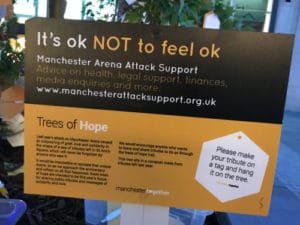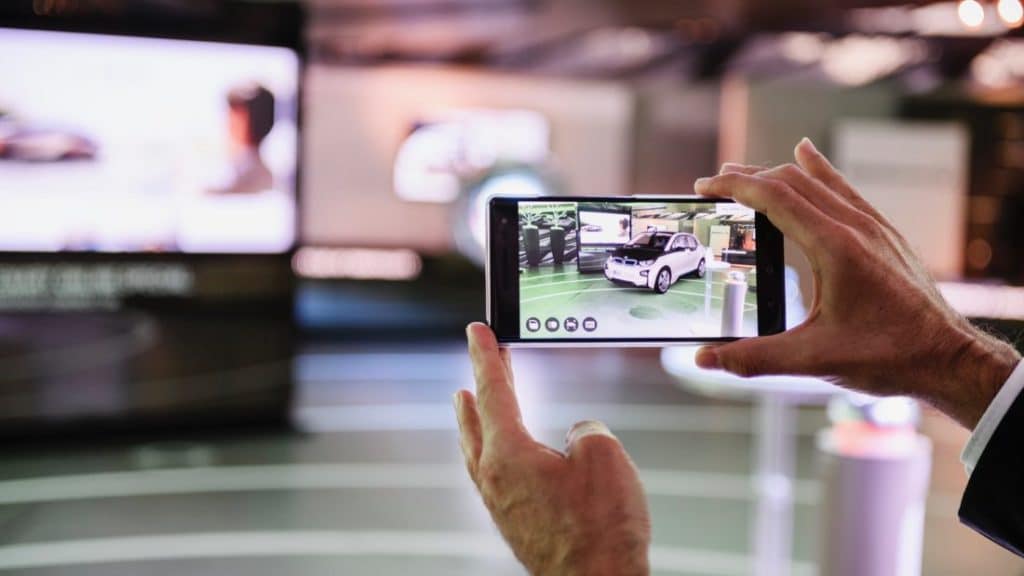Somewhere in suburban America, a woman leads her partner out the front door to show him the car she wants. She points her phone at the quiet street and a blue BMW appears. As they walk around it—viewing the exterior, opening the doors, checking out the interior—a neighbor shakes his head. From his vantage point, they’re pointing at something invisible.
Such is the 2018 ad campaign promoting BMW i Visualizer, an augmented reality (AR) experience the German car brand developed in partnership with Accenture Interactive. It’s just one example of the growing use of AR in advertising and sales.
“In our initial tests, we saw people ducking down when they were getting into the car, as if there really were a roof there for them to bang their heads on,” said Andrea Castronovo, BMW Group Vice President, Sales Strategy and Future Retail, in an Accenture case study.
“It’s that level of detail which means this technology offers the customers real added value.”
BMWs and Pokémon
Global corporations like BMW are increasingly using AR to educate their customers, fill a genuine need, and increase e-commerce sales. Indeed, the technology’s uses are rapidly evolving since the 2016 pop-culture sensation Pokémon Go. Powering these innovations are Google Tango, which has been superseded by Google’s ARCore, Facebook Camera Effects, and Apple’s ARKit 2.
“AR, VR (virtual reality), and MR (mixed reality) are all being sandwiched under the umbrella of XR: extended reality,” said Omnigon Chief Design Officer Bora Nikolic, who uses all three platforms on behalf of clients including NASCAR. “Extended reality will disrupt the entire computing industry, making smart phones ultimately obsolete. It’s a whole new paradigm that will affect society in an amazing way.”
The technology is following the demand for deeper user experiences, said Facebook app developer Paul Gailey Alburquerque. “Brand suitability will vary but user expectations for ever-more compelling content and interactions are relentless.”
Welcome to the New Realities
While extended reality terms are used interchangeably, each technology yields a different experience. Phone-enabled augmented realities are built on top of the physical world, such as an invisible car or a virtual Pokémon. VR, on the other hand, might require a headset to enter a new setting, blocking out their physical space. One such example is IKEA, which did a pillow-toss game in a make-believe living room.

Mixed reality goes much further, enabling people to move and interact with digital objects, including holograms. With Microsoft HoloLens, for instance, a surgeon could extract a virtual heart from a human body for closer study—in mid air. For now, Microsoft is marketing its MR headset to academic, scientific and corporate audiences. Meanwhile AR and VR are gaining traction in the consumer space.
What Consumers Want
“Now that we’ve moved beyond the hype cycle, brands are getting more serious about assessing what the consumers’ needs are first, and then developing ways to make those needs come to life,” said Whitney Fishman Zember, head of innovation and consumer technology at Wavemaker, IKEA’s media agency of record. “Is it a physical experience of hiking up a mountain to test a pair of hiking boots in any condition? Is it being confident in buying home goods so the dimensions are an exact fit? You need to know how you want people to feel.”
Every moment of delight, every transaction, will contribute over time to massive disruption in people’s lives and business.
In 2022, AR and VR will represent a $61 billion market comprised of advertising. According to ARtillry Intelligence, this includes software such as games and apps, smart phones and glasses, and headsets. Within four years, “VR has a place in the enterprise but is a bigger consumer play. Enterprise and consumer AR widen their lead in extended reality revenue share,” the report states.
Extended Reality “Superiority”
Citi Managing Director Kota Ezawa predicts that the majority of growth in the headset market will occur from 2025 onward. By then, AR and VR devices will be more affordable and demonstrate their “superiority” to computers, smart phones and TVs. By 2035, he predicts AR will drive 25% of the mobile commerce market, or $1.3 trillion in sales.
“We believe there could be a noteworthy migration of time spent to these new platforms, which will force brands, advertisers, and other marketers to significantly adjust their strategies for influencing consumer behavior,” Ezawa wrote in a Citi report.
Alongside today’s massive disruption are AR executions complementing the cornerstone of traditional advertising: artistry, an approach used by Barcelona-based Everywoah. Since Facebook’s 2017 invitation to become beta developers of the platform, Everywoah has created AR and VR experiences for myriad brands and entertainers. For its Spring 2018 line, AR reflected the style of its creative director and photographer Jean-Paul Goude.
“Desigual’s creative was quite wacky—all this grass and lots of butterflies, crowns of flowers used to wrap entire buildings, almost catwalk fashion wild,” said Alburquerque, founder and CEO of Everywoah.
AR Where it Counts
Using Facebook’s open API to create selfie filters, Everywoah developers created an app that fashionistas around the world used to dress themselves up in the advertising’s floral garb and share their fantastical appearance on the social network.
“Hey guys, are you freaking out by my new look?” asks a rosy-cheeked twenty-something surrounded by lush green grass and topped off by a headdress of pink flowers. Her video on Desigual’s Facebook page garnered 1500 likes, 104 comments and 120 shares.

And AR heals wounds, as in the case in Manchester, England, where a terrorist killed 22 fans at an Ariana Grande concert.
AR helped to spread the love and raise funds for the survivors at Manchester’s Parklife Festival June 9 and 10.
Everywoah created an AR Facebook app to foster community and financial support of the Manchester Emergency Fund. Developers chose a gesture—an eyebrow raise—as the catalyst for special effects. Each time someone followed the prompt, an image of an “I Love Manchester” message would appear around their face. What’s more, real-time donation tallies appeared, too. With the content going viral with a “try it” button, AR played a major role in the donation effort.
Said Alburquerque: “Facebook’s Camera Effects gives us an imaginative way to display contextually relevant information virtually, on top of something happening in real life.”





Join the conversation